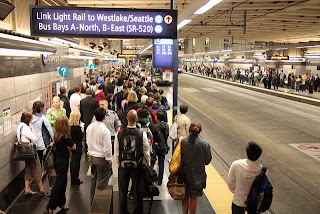The End of the Ride Free Area
~ "Back door!"
So shouted the tired office worker in the direction of the Metro Transit bus driver down the Westlake Station platform of the Seattle Transit Tunnel.
The driver didn't respond. The commuter, wearily, headed toward the front door of the bus, annoyance clearly visible on her face. Boarding through all doors was already a dim memory.
It was just past 5:30 on the first weekday following the elimination of Seattle's downtown ride free area and clearly not everyone was with the new program. Metro did away with the downtown Ride Free Area in an attempt to save the $2.2M of evaded fares in their operating budget of $549M. Those relatively meager (and theoretical) savings are changing the ease, appeal and convenience of taking public transit.
Just south of the International District Station, yet still in the tunnel, 90 or more of my fellow riders and I sweltered in the bus as it remained stopped with the minutes dragging by.
The driver's voice crackled over the PA system: "Just to bring you up to speed folks," he started. I'm sure I wasn't the only passenger in that moment wishing instead that he was bringing the bus, not us, up to speed. "This bus left the CPS [Convention Place Station] at 5:25. We've been in the tunnel about half an hour. Normally it takes about 10 minutes." The reason of course, he explained, was the need to funnel everyone through the front door to make them pay as they got on. "The good news" the driver noted, is that when we eventually got to our stops, we could exit at will through both doors since everyone "should have" paid their fare already.
I have never seen the tunnel so jammed with buses. As people patiently filed through the front doors to pay their fares, more rush hour commuters kept streaming down the stairs. The drivers would shut their doors, but the buses in front didn't move, and they'd end up opening the doors again to let more people on. The 218 was already standing-room-only at Westlake, and by the Pioneer Square Station, there was no more room for anyone else to get on.
Sitting at the very back of the bus I just wished we would get going. It was one of the newer buses where none of the windows open. Packed to capacity with tired people an the end of the office work day it was utterly airless and stuffy. The fellow next to me was wearing a down parka. Dude, yeah, it's October, but the city was almost 80 degrees this afternoon! I felt like I might start sweating just looking at the guy. Lots of hot and bothered faces all around.
We eventually escaped onto the I-90 ramp about 6:05, 40 minutes after leaving the CPS. The driver turned on the air, and sure enough, we spilled out of the bus at each stop, although I can't say it seemed a whole lot more efficient. Certainly not to justify the extra half hour snailing through the tunnel with passengers nearly in each other's laps.
The end of the Ride Free Area may let Metro recoup that $2.2M, but I wonder how many riders will give up on taking the bus. What will that cost? Time, and the patience of riders, will tell.
Getting rid of the Ride Free Area is a mistake, and the congestion today proves it. Perhaps it will get better as everyone adjusts, but it is hard to see how any part of the process can be appreciably sped up as long as every rider needs to pay a fare as they get on at the front door. The delays in loading are too long, and the flow of new passengers onto the platforms nearly match the ability of the buses to process fares through the single door.
One solution would be for Metro to institute more Rapid Ride routes. These buses can be boarded through all 3 doors and passengers can prepay from ORCA readers. They're fast and efficient, behaving much like a bus version of light rail or a municipal subway. If all the buses in the Transit Tunnel were Rapid Ride, the congestion would largely go away.
There are implementation costs with the Rapid Ride, especially installing ORCA readers at all the bus stops, but the benefits are clear. In particular, Metro could create a Rapid Ride route from the Transit Tunnel across I-90 to Issaquah, and perhaps all the way to North Bend. There are only a few stops: Rainier, Mercer Island Park-and-Ride, 142 PL SE, Issaquah Park-and-Ride, and, if they go all the way, stops at Exit 22 in Preston, Snoqualmie Parkway, and North Bend. Not too many, and they could then optimize the chaos of routes 554, 209, 212, 215, 216, 218, and others by using the Rapid Ride as a backbone and creating feeder/distributor routes based on its various stops. Probably need a few more Park-and-Rides too while they're at it.
Other routes in the tunnel could also be redone this way. Replace the 550 with an extended B Line that goes all the way downtown (until the East Link is built.) The 71, 72, and 73 to the U District could be another line, as could the 255 to Kirkland and Totem Lake. The south end buses could use such a system too.
Ridership has been rising for several years, and the demand will almost certainly continue. More investment in building an efficient and usable system will be needed.
Cross-posted to Fare-Free Northwest blog.

I think it would be very interesting for you to know that public transportation provides access to job opportunities for millions of Americans. Almost middle-class American people are getting their work just because of a public transportation system.
ReplyDeleteBest Moving Company Chicago